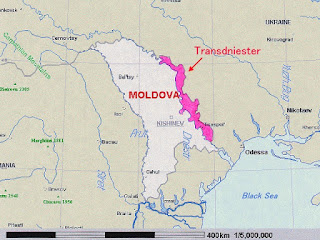Back
in December 1941, all of the wireless and radio stations on the island of Guam
were either badly damaged or totally destroyed at the time of the Japanese
invasion and occupation of the island. The large and important American naval radio
station NPN at Nimitz Hill was destroyed in a Japanese air raid during the
initial attacks on December 10.
During the nearly three years of
Japanese occupation, there was almost no American radio activity on the island,
though there were a few occasional clandestine transmissions. The Japanese occupation forces installed
their own temporary radio communication facility, which we presume was
somewhere within the areas of the island capital Agana. This station was also destroyed by aerial
activity when the American forces made a bombing raid on July 16, 1944; and
they secured the island a little less than a month later, on August 10.
American radio communications were
provided initially by the USS Appalachian at anchor in Agat Harbor, quite near
the coastal area whereon the AWR shortwave station KSDA is now located. The Appalachian, under the regular navy
callsign NCLG, arrived in Agat Harbor on July 14 (1944) and they maintained
sector communications until they departed for Pearl Harbor on August 10, a
period of nearly one month.
Apparently another ship in Agat
Harbor took over the communication role until a temporary land based station
was installed somewhere in the Agat area.
This new station was first noted in the United States on 15260 kHz under
the callsign NPN8, just after mid September (1944).
In the meantime, reconstruction was
underway for a permanent facility, with station control in the naval
headquarters on Nimitz Hill, the transmitters at Barrigada, and the receiver
station at Finegayan. A total of 91
shortwave channels were allocated for use by the new naval station NPN, and the
callsign K2XO was introduced for communication with other Allied centers throughout
the Pacific.
In
March 1945, this new naval radio station was inaugurated for regular usage, and
it went on the air under the tactical callsign KU5Q. At this stage, three transmitters were in
use, each rather low powered, with at least one rated at 2 kW. However, propagation to Asia, the South
Pacific and the United States mainland was usually very good, due to the
extended saltwater pathway across the Pacific Ocean.
For a year or so, the Finegayan
receiver station was also in use for the monitoring of Japanese radio traffic
in the Pacific. A radio analysis group
was formed and they operated under a temporary callsign NIM.
The new KU5Q was often noted in Morse and voice communication with Asia,
the Philippines, California, Hawaii and other islands throughout the Pacific,
as well as with naval and commercial shipping in nearby waters. On many occasions, the station also relayed
radio programs for onward broadcast to and from Pacific rim countries, programs
that included news bulletins and commentaries, sports, and local music programs.
There were occasions also when KU5Q
was noted in Australia, New Zealand and the United States with a relay of the
programing from the AFRS mediumwave station WXLI. The studios for both KU5Q and WXLI were
co-located at Mt Alutom, a few miles southwest of Agana.
In March 1945, KU5Q relayed live
commentaries from a navy vessel during the American invasion of Okinawa for
rebroadcast in the United States. Then
in September 1945, KU5Q played a key role in the relay of news and information
to and from the United States for the Peace Ceremony and the signing of the
peace documents in Tokyo Bay.
At this stage, it was officially
announced that the international communication services rendered by KU5Q on
Guam, and hence the usage of the callsign KU5Q, would cease at the end of the
month of October. However, the usage of
the KU5Q international relay service was extended for exactly one more year.
In July 1946, KU5Q served as a
co-ordinating relay for radio communication with navy vessels associated with Operation Crossroads, the
American atomic tests over Bikini Atoll.
At this stage, KU5Q operated with six transmitters, five at 3 kW and one
at 10 kW, a TEC model manufactured by Press Wireless.
There were many occasions when KU5Q
was on the air with four transmitters in parallel. The antenna systems were unidirectional
rhombics, 860 feet long.
During the final month or two of
service under the callsign KU5Q, the station was under the control of the naval
Public Information Service. QSL cards
and form letters were issued, and the greatest quantity of reports, they
stated, came from Sweden.
The usage of the tactical callsign
KU5Q ended in 1946, though this naval radio station continued in regular
communication service under the original naval callsign NPN. The station was rebuilt in 1954, with a new
receiver station adjacent to the older station at Finegayan, and a new
transmitter station at Barrigada.
The American naval radio station NPN
on the island of Guam has also issued QSL cards for its communication
transmissions with the callsign NPN in large letters superimposed over a map of
the island of Guam.
(AWR Wavescan/NWS 365 via Adrian Peterson)













